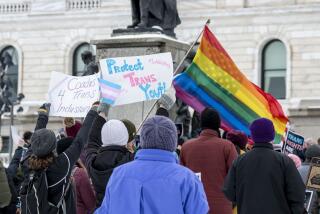‘Between XX and XY: Intersexuality and the Myth of Two Sexes’ by Gerald Callahan
- Share via
Chastity Bono’s decision to physically become a man has left us to wonder: What happens to those who are physically one sex but want to be the other? Human sexuality then becomes something that has shades of gray, varied interpretations and repercussions far beyond the bedroom.
In “Between XX and XY: Intersexuality and the Myth of the Two Sexes,” author Gerald Callahan breaks down the general belief that there is only the male and the female. He argues that the idea that there are only two sexes is a mere myth we hold on to to make sex simple.
After discovering that, every year, more than 65,000 children are born who are not obviously boys or girls, Callahan wondered, “Why has this become so arcane? Our classical preconceptions about sex do not fit with the real world.”
Unlike Bono, those born as intersex individuals cannot be traditionally identified. “I do see transgender and intersex as two very different things,” Callahan says. “Most transgender people fit what we think as a man or a woman should be, and yet they don’t feel like the sex that they are. In intersex, from the onset, no one can comfortably put a pronoun on the person.”
In the book’s stand-out chapter, “Outcomes: Sex, Surgery, and Satisfaction,” the author tells the heartbreaking story of Bruce, Brenda and David -- an individual who was born as a boy but whose penis was damaged during a surgical accident. It was decided that the boy, at 21 months of age, should become female. They removed his testicles, began a feminization process and Bruce became Brenda.
After living as Brenda until age 14, she felt so strongly like a male that she made the decision to have surgery and become David. At age 25, David fell in love, got married and adopted children. But, as Callahan relates, he felt so inadequate as a husband and father that he ended his life in 2002 -- he shot himself in a grocery store parking lot. He was 38.
Confusion, despair and the feeling of existing as “the other” riddle the lives of those who are born as intersex.
The claims about surgeries making people happier are grossly exaggerated, Callahan says. Surgeons report that their patients are satisfied and generally pleased, but the patients themselves hide their self-doubt and discomfort.
Surgery aside, the author is clear that the physical is not the primary issue. “The biggest problem for intersex people isn’t surgery, it’s shame,” he says.
A bit of light is offered in his last chapter, as the author points to the novel “Middlesex” by Jeffrey Eugenides and to TV shows like NBC’s “Will & Grace,” which have helped to bring gender stratification -- and simply being different -- into a more favorable public context.
More to Read
The biggest entertainment stories
Get our big stories about Hollywood, film, television, music, arts, culture and more right in your inbox as soon as they publish.
You may occasionally receive promotional content from the Los Angeles Times.










